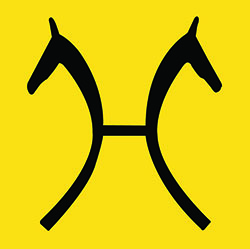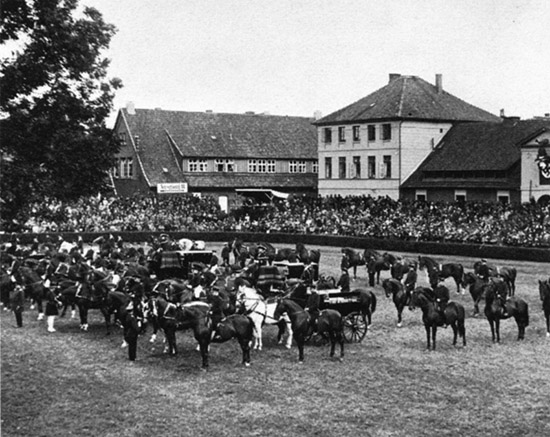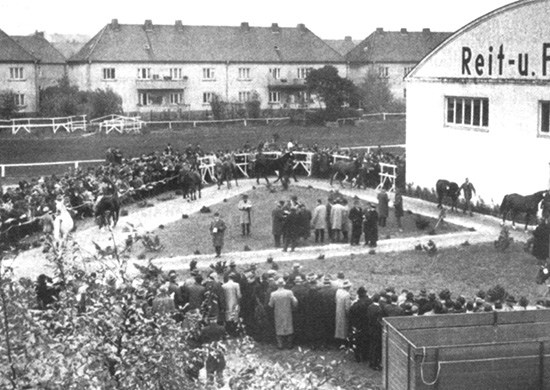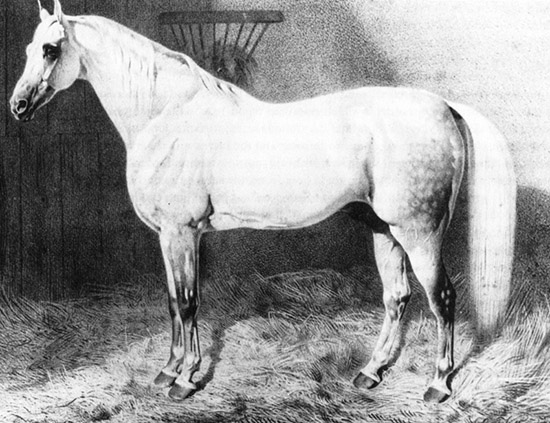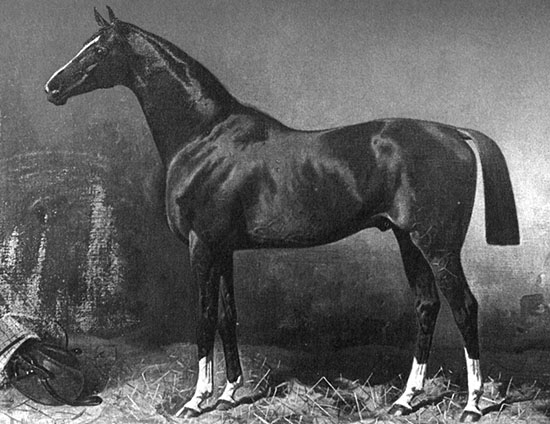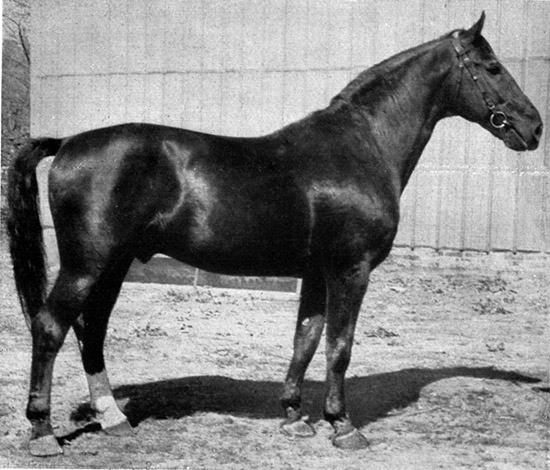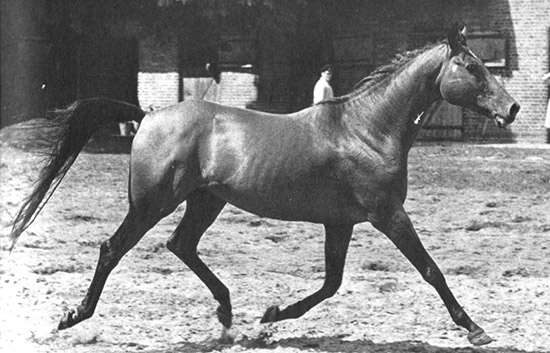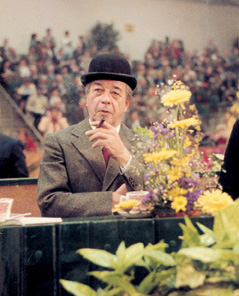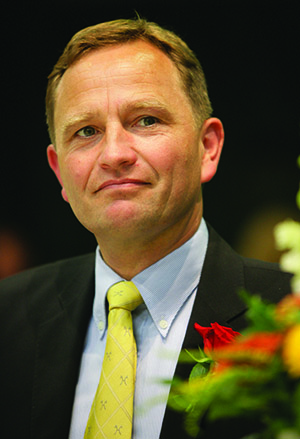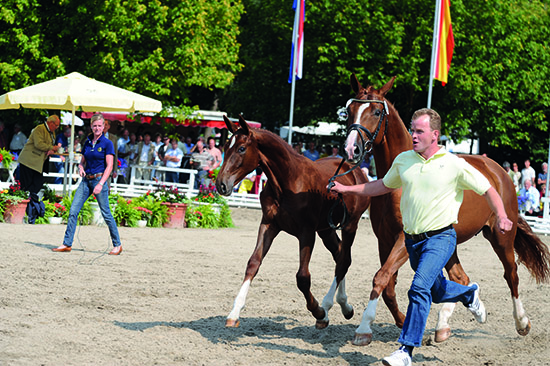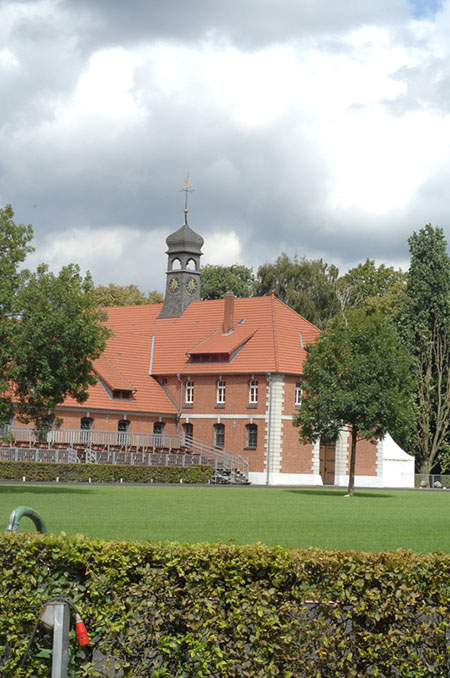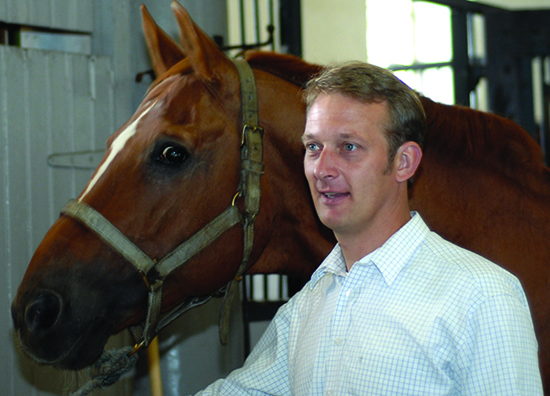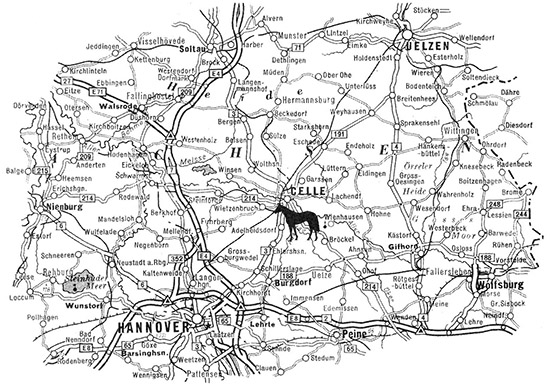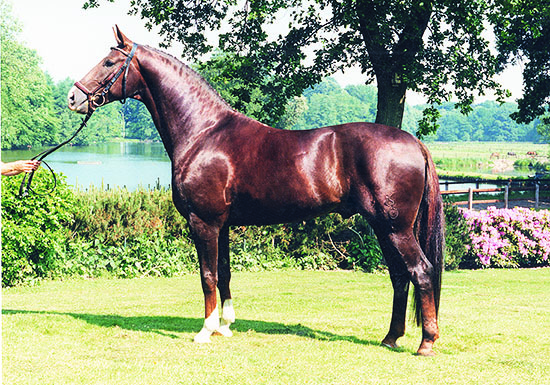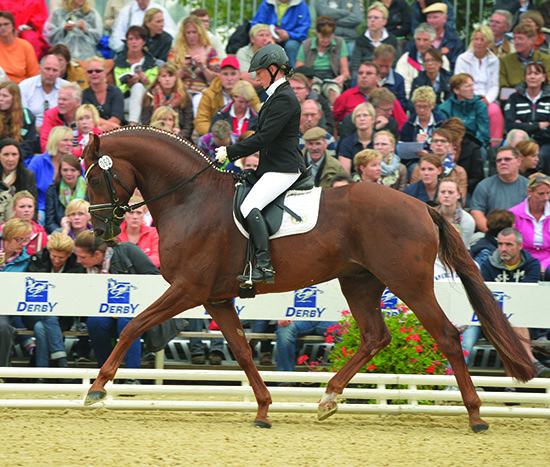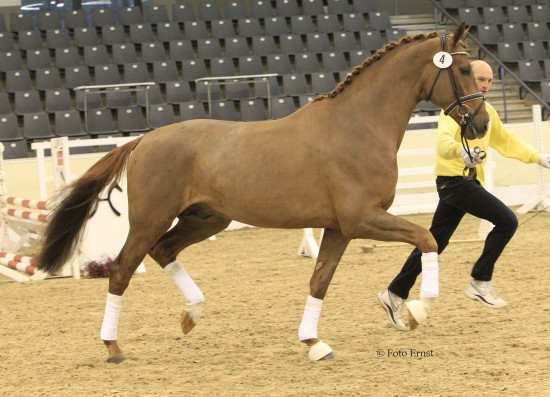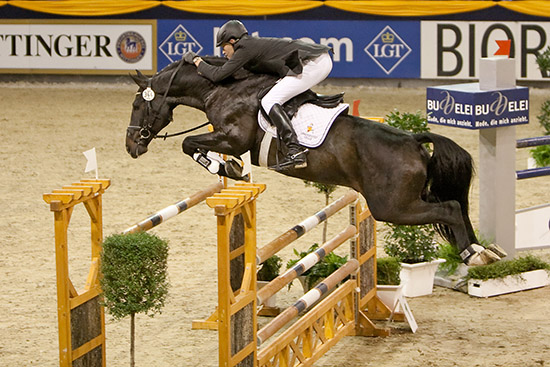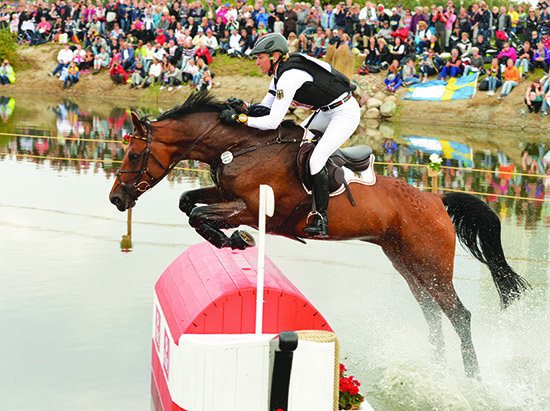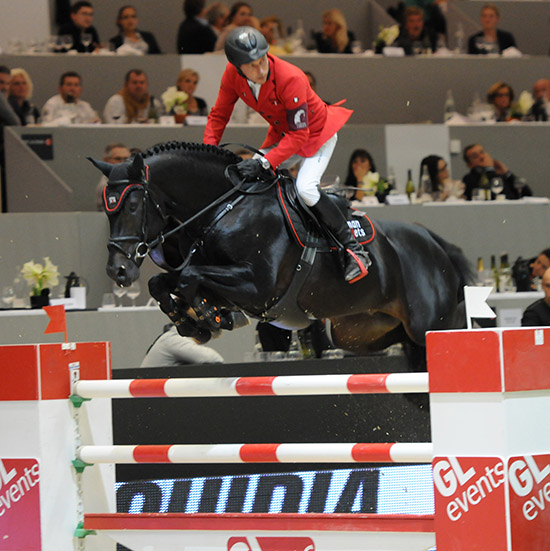The Hanoverian
At the heart of Hanoverian breeding is Germany’s most influential state owned stud, Landgestüt Celle, and the largest Warmblood breeding association, the Hanoverian Verband at Verden.
A stallion display at Celle…
Stallion licensing at Verden, 1968…
Hanover has played a major role in the shaping of the modern Warmblood – particularly the dressage specialists…
In many people’s minds, the Hanoverian set up, is THE model of a German studbook, but there are quite extreme differences in the organizational structure of the German books.
For the Hanoverians, there are actually two quite distinct entities involved – the State run stallion station at Celle, and the Hanoverian Verband, or association of breeders, which has its headquarters at Verden.
The Stud at Celle was initially founded in 1735 by the Elector of Hanover, who was also George II, King of England. He decreed that ‘we shall set up a public stud, as a special favour, with twelve stallions to start with.’ Roger Brown – presumably an Englishman – was the first huntsman of staghounds at Celle, and he was sent to Holstein to purchase the 12 founding stallions.
By 1745 there were 50 stallions at the stud, mainly still from Holstein. From about 1775 onwards, home-bred stallions from Mecklenburg and England began to dominate the scene. By 1776, the Celle stud had grown to a point where it was transferred from the King’s personal responsibility to that of the government.
More and more Thoroughbred stallions were imported – now directly from England rather than via Mecklenburg, until by 1840,one third of the stallions were Thoroughbred and the remaining two-thirds were either half-bred or quarter bred.
Sebras – the English part-Thoroughbred stood at Celle from 1846 to 1863
After 1844, all stallions standing in the region of Hanover had to be licensed. This trend had started much earlier for in 1715, Prince Georg Albrecht issued licensing rules for a limited area in the northeast of East Friesia and in 1755 all East Friesia followed suit. Gerd–D. Gauger in the article, ‘Always Exciting’ in The Hanoverian, 5/02, details the outcome:
“Other areas followed this example. At the time, the shape of the stallion was still the criterion for evaluation, maybe the movement gained in interest, but only the trot. Very slowly another aspect gained in popularity: the type. The type stood for the exterior of the horse, which allows it to perform within its genetic disposition. The State Stud Celle was established in 1735. In its beginning, it already divided its stallions in three different type categories – without actually licensing them: 1 = The refined riding horse type, 2 = The heavier riding horse and lighter driving horse type, 3 = The heavy driving horse type. With this format, Celle’s State Stud managers already selected the sires by performance requirements, a predecessor to today’s division in stallions with dressage and stallions with jumping ability.”
“For a long time stallion licensings were solely based on the exterior evaluation. But even Thoroughbred breeders, who were strictly performance oriented, could not always count on their top performers. For instance, the legendary horse West Australian who won the 200 guineas, the Derby and the St Leger in 1835, was a terrible producer. A research project with Hackney ponies from 1886 until 1914 proved that licensed champions almost always failed to produce champions, that however, stallions which did not shine at breed shows, produced one champion after another. This happened more than once in Hannover as well as in other breed associations.”
“Once new provisions were added to the existing licensing rules, its reputation changed. It was no longer viewed as only a moment’s evaluation. The inspection of the first vintage of a young breeding stallion was one provision (which was made mandatory for East Friesia first). Another provision was the stallion’s own performance in a stallion performance test (Trakehnen 1926, Hannover 1927, East Friesia already performance tested their mares since 1928!). The third provision, the youngest, the most objective and possibly the most effective, is to record the competition performances of the offspring of each breeding stallion.”
Between 1830 and 1890 about 100 English coach horse stallions were imported, producing a larger more substantial horse.
Kingdom xx, a State Stud stallion at Celle between 1882 – 1898
In 1867, the first breeding policy was formulated: “To produce a large, powerful horse with substance, a strong coach horse and at the same time, a useful army horse.” But by the beginning of the twentieth century breeding authorities realised that the horses were becoming too big and coarse – and once again turned to the Thoroughbred. The three most important Thoroughbred stallions were Kingdom, at Celle 1894-1906, Devils Own, 1894-1906, the line that leads to Donnerhall, and Adeptus, 1884-1904, this line became the E line, and continues through Eiger I, sire of Espri who is in turn the sire of the two Escudos standing today in Celle.
In 1922, the Verband Hannoverscher Warmblutzüchter was formed to represent the breeders with the breeding aim of: “A Warmblood horse with as much substance as possible, which can undertake any type of farm work, but which has enough ‘blood’ and courage, and enough paces to make a riding and driving horse of substance.”
In the period between the two world wars, with the disappearance of the cavalry, the demand was for heavier horses of an agricultural type: even the Army paid more for a coarse artillery horse than for a potential cavalry mount.
Born in 1930. Almjäger I, shows the heavier type that developed between the wars – he descends from the Thoroughbred, Adeptus
However there was at the time a movement headed by Gustav Rau, a man who was responsible for the development of Germany’s huge number of riding clubs, to encourage riding in the rural community, and as a result, some of the breeders’ sons became interested in riding. Equestrian sport started to spread from a small group of military officers and wealthy enthusiasts, to the farming community, and even in the period 1920 to 1940 there were a number of Hanoverians who proved themselves ‘in the sport’.
The end of World War II was a disaster for horses. They were no longer needed due to the mechanisation of industry and agriculture, and the number of mares in the Hanoverian book fell from 30,000 in 1948, to 6500 in 1963. The number of stallions declined from 539 to 149.
However this drastic reduction also had the effect of improving the stocks of the Hanoverian – only the very best and most suited to the new performance horse market were kept. And because the Hanoverian had always been at least in part, a riding horse, the transformation was easier than it was in some other parts of Germany.
One of the Thoroughbreds that helped transform the modern Hanoverian, Marcio xx (by Aventin) stood at Celle from 1959 to 1965
This make-over was accelerated by the increased use of Thoroughbred and Trakehner blood. From 1945 to 1950, the proportion of Thoroughbred blood had fallen to 1.8% of the total population. By 1965, out of 160 stallions based at Celle, 6.9% were Thoroughbreds, a percentage that had risen to 11% by 1975, when 23 of 208 state stallions were Thoroughbred.
The Hanoverian was back and with an exceptional marketing and promotional campaign, ready to take on the world.
The hunt was on to breed a horse that would cater for the new sport horse market, and Hanover quickly led the way. This was a double-sided process. The Stallions in Celle became lighter, more ‘modern’ and at the same time the introduction of the first of the great modern performance horse auctions in Verden intensified the transition. The Verden Auction was the brainchild of the master horseman Hans Joachim Köhler (1917 to 1997) and if the breeders wanted to make money selling their horses at the Auction, they had to produce the sort of horse Köhler liked. And Köhler liked ‘blood’.
Köhler held his first auction in 1949. He retired 35 years and 70 elite auctions later, handing over responsibility to Reiner Kiel after the spring auction of 1984.
Köhler was also instrumental in producing a group of exceptionally talented riders who came out of his auction team and went on to play key roles in the developing sport horse industry in Germany. Hans Günter Winkler was already a star when he became a member of the auction team in the early 50’s, but riders like Ulrich Kasselmann, and his wife, Bianca, who went on to establish Germany’s premier dressage horse sales centre, PSI, which is managed by another former auction rider, Ulf Möller, one of the masters of the newly emerged young horse classes, learnt their craft under Herr Köhler. Riders like Holga Finken, another master of the Young Horse classes, Hans-Heinrich Meyer zu Strohen, coach of Germany’s young dressage riders, and Holger Schmezer – who went on to coach of the German dressage team, all worked in the auction team. Others included Inge Theodorescu, Helga Köhler and Tjark Nagel. The long time public relations manager of the auction, Enno Hempel, also learnt the job ‘hands on’ starting as an auction rider in 1966.
Not only were the Hanoverians producing a new type of Sporthorse, the Verden Auction was also part of the process of creating a class of trainers and riders who could expand the market for the new horse…
Some measure of the success of the auctions can be seen in the steady onwards and upwards average prices. The first elite auction took place in a barrack-area at the eastern border of Verden in November 1949. There were 18 horses sold at the average of 1.900 DM.
The average prices and numbers of sold horses in the fall auctions:
1959: 54 horses for 4,634 DM
1969: 86 horses for 12,570 DM
1979: 178 horses for 16,702 DM
1989: 114 horses for 25.877 DM
1999: 67 horses for 55,343 DM
2002, the first year of the Euro: 74 horses for €29,385
2007: 92 horses for €45,967
2008: 103 horses for €40,266 – In 2008, the six auctions, saw 584 horses sold at an average price of €21,390 but it should be noted that the averages varied from €40,266 at the Elite auction to €12,71 at the November auction. Interestingly the top price was for the showjumper, Levistan (Levisto / Argentan) for €310,000. The top price for a dressage horse of €195,000 was paid for Bacchus von Worrenberg (Belissimo M / Calypso II).
2009: 84 horses for €37,181
2010: 86 horses for €35,500
2011: 85 horses for €43,282
2012: 62 horses for €31,863
2013: 64 horses for €43,809
The first elite-foal-auction was held in 1975, it was the debut of auctioneer Friedrich-Wilhelm Isernhagen. 68 foals were sold at the average of 4,688 DM.
1985: 99 foals sold at 5,593 DM
1995: 141 foals sold at 8,766 DM
2002: 157 foals at €5,804
2007: 325 foals at €8,373
2008: 316 foals at €8,167
2009: 312 foals at €6,913
2010: 246 foals at €6,885
2011: 264 foals at €9,908
2012: 252 foals at €6,333
2013: 221 foals at €6,572
The Hanoverian Verband also leads the field when it comes to public relations savvy – there is no German breeding organization quite so journalist friendly, and the Hanoverians spread their influence further through the Study Tours they run for Hanoverian enthusiasts from all over the world. The Hanoverians have put into place by far the most extensive and successful worldwide network of friends and breeders of the Hanoverian horse, happily exporting semen and expertise to assist breeders all over the world.
In an interview in 2007, Hanoverian Director, Werner Schade explained the relationship, which now offers non-German Hanoverian enthusiasts both direct membership to the German body, and membership of ‘daughter’ associations:
“This expansion is, very simply, the result of successful sales in the last few years at our auctions. We now have very good contacts in many countries, and the horse owners are coming back to us and saying ‘we would like to breed Hanoverian horses in our country, please help us – please give us advice, please give us the brand.’ They want to be a part of the family, but the numbers in those countries – I’m talking about Spain, Italy, Russia – are too small to found daughter societies, so they are offered the option of direct membership to the German society.”
“In North America we have had this situation for some time. In the United States, there is the American Hanoverian Society, a very successful association – while in Canada, we have direct members of the German Association. So we have both situations. I think we have to look at the individual situation in the countries, and both ways are possible. We will continue to work with the daughter associations; in fact we would like to strengthen them. We don’t think there is a big difference between direct membership and working with daughter societies, the relation to the daughter associations is very good in every country. The ability to work closely together is very good. For us, it is not a big step, it is a new formula for a new situation. It’s a big international family, the family of Hanoverian breeders.”
“Our intention is to have a leadership from Germany but to develop one thinking: one breeding aim, one philosophy of the horse, and to give the support to the breed all over the world. We are becoming more international because we are convinced that the more members we have, the better the marketing for the Hanoverian Horse. Every breeder is a flag waver for the Hanoverian Horse. For us it is very interesting to be in other countries, it doesn’t matter where you are, if you are among Hanoverian breeders it is global.”
My suspicion is that in Australia, there are many people who buy Hanoverian semen, and even buy Hanoverian horses in Germany, who are not members of any breed society…
“We know that – not just in Australia – we have breeders who are not interested in the brand, they are Sporthorse breeders, and they don’t worry about licensed stallions or anything like that. I think it is an English phenomenon. The English speaking breeders are much more individual, they are not so interested in rules. Maybe it is not possible to get all the breeders under one roof. Here in Germany we have competition amongst the breeding associations, and we have to offer a good service, good marketing, so there is a high value placed on the brand. We have to give the breeders a good feeling, to make them want to be part of our association, but in Germany it is unthinkable to breed horses and not be part of some association.”
I guess the two most successful breeding associations in Germany are the Hanoverian and Holsteiner Associations – and yet the philosophy in regards to ‘globalisation’ could not be more different? The Holsteiners are not so keen on marketing semen around the globe, they don’t want daughter associations around the world, they don’t even want more members unless they live in Schleswig-Holstein. When I talk to Mr Boley (Managing Director of the Holsteiner Verband in charge of the stallions, breeding stations and auctions), he wants to keep the numbers small, and he would like to confine it all to the traditional breeding district – it is the reverse of the Hanoverian worldwide policy?
“I think it is very interesting but it is very difficult to compare the associations. The Holsteiner Verband is a specialised association focussed on one discipline – jumping. Holstein is like a kind of island, whereas in our breeding district we have many borders around us, and relationships with breeding associations near us – we even have two breeding associations in Lower Saxony: the Oldenburg in one region and the Hanoverian in the other. We are bigger, and we have with our daughter societies, a different level of development. It could be the right decision for the Holsteiners to have this concentration, but I don’t think it would be the right policy for us.”
“We see a passion in other countries to breed Hanoverian horses, and people do this in their own countries, and they also breed horses here in Germany. We have many horses in our breeding area that are owned by breeders who are not Germans. We have many Italian, Spanish, American horses and they are here to be raised, to be trained, so our strategy is not to close the breeding area, but to open it up. To not only sell horses, but also to sell the experience and the knowledge. We have much better conditions here for horses to grow than you find in Spain or Italy. We think if you look at the economic situation, this is good for our situation here in Lower Saxony.”
“We also have a big change in the structure of our breeders. We are losing the traditional type of breeder, the farmer breeder. More than 50% of our breeders don’t have a farming background, so we think it is very good to give them the support and to offer services to these international clients and breeders. We want this international cooperation.”
“Of course we have some breeders who say, you are too open, and we will lose the connection to our own base! But in the end, I think what we win with this strategy. There are more advantages for our breeders than disadvantages.”
The State Stud Celle
The Regional Stud at Celle was founded on 27 July 1735 by King George II, the Elector of Hanover and King of England. By about 1800, the Celle Stud owned 100 stallions, which were sent to some 50 covering stations every year, principally to the present administrative districts of Stade, Lüneburg and Hanover. From the beginning the mares sired by state-owned stallions were registered. Around 1790, the stud-farm began to record pedigrees for the progeny of its stallions and registered mares, thus laying the foundation for an independent, planned Hanoverian breed, whose origins can be traced back over 200 years to its tap-root dams.
The stud suffered heavily during the Napoleonic Wars, and only 30 of the stallions that had been evacuated to Mecklenburg returned in 1816 to help re-build breeding in the area.
By the start of the First World War, the roster of stallions had increased to 350 and by 1924, to 500. As a result, another regional stud was established at Osnabrück-Eversburg in 1925, with 100 stallions and 30 staff. In 1921, the stud administration took over the Hunnesrück-im-Solling estate of some 600 hectares and the practice of the stud buying colt foals to raise as prospective stallions was established.
Towards the end of the 1920s, the number of stallions in the regional stud farms started to fall, but after the Second World War, rose to a new peak of 380 stallions at Celle and 180 at Osnabrück.
The mechanization of agriculture led to a severe recession in horse breeding in the post war years, and the Osnabrück and Harzburg stud farms were closed and the staff and stallions returned to Celle. In 1960, the number of mares covered by the 179 stallions had fallen to 4238, the lowest point in history. This reduction had the effect of improving the quality of the breeding material, thus paving the way for the revival of the Hanoverian as the ultimate modern sport horse.
In 2006, the stallions from Celle, covered some 6,972 of the 13,356 mares in the Hanoverian breeding district while private stallions covered 6,090. However in 2009, the number of mares covered had fallen to 12,599, with Celle stallions covering 6,370 and the private stallions 6,059. The total membership of the Hanoverian Society has also fallen slightly, from a high of 15,464 in 2005 to 15,197 in 2009. The number of registered mares has also fallen from a high of 19,980 in 2008 to 19,695 in 2009.
Alas as with all the breeding areas, the numbers continue to fall: 2010: 10,719 mares; 2011: 9,935; 2012: 9,066; 2013: 8,302
Stud director, Axel Bröckmann with Weltmeyer…
The State stallions spend the winter in Celle, where now the stables are as nice on the inside as the buildings are on the outside. Gone the days where the stallions were imprisoned in chains, they now all have roomy stables and are regularly exercised – by the regular grooms and riders, but augmented by administrative staff who get to ride ‘their’ stallion.
In the past when the breeding season rolled around, the stallions were sent out to little breeding stations – each standing two or three stallions – dotted around the countryside. Now there are larger stallion stations each standing about eight stallions, with 29 live covering stations with one stallion at each, for the truly traditional breeders: obviously, these are not the top stallions, indeed the most important 22 stallions live permanently at Celle or Adelheidsdorf. But where they stand is pretty unimportant these days, with more and more mares being bred with chilled, transported semen.
Fresh cooled semen was first used at Celle’s artificial insemination station during the breeding season of 1985. In 1986 a pilot program at the insemination station at Landsbrück commenced, and in 1993, all breeding stations switched over to artificial insemination with chilled semen. Now 98% of the mares ‘covered’ by Celle stallions, are recipients of chilled semen – with just 2% covered live.
UPDATE: 2014
It had been seven years since my last interview with the director of the Hanoverian Verband, Werner Schade in 2007. In that time, so many dramatic changes had occurred in the world of Warmblood breeding, changes that neither of us could have predicted seven years earlier. Who would have thought that the whole French National Stud system would disappear? That Flyinge, the jewel of Swedish breeding would disappear? That most of the great Oldenburg stallion stations would disappear? And that the numbers of mares being bred throughout Europe would have fallen so dramatically…
“I think the biggest changes have been structural,” replied Werner, “The changes in the community of breeders. We see many breeders with a farming background have given up breeding in the last few years – with the change of generations, whole farms have disappeared. The number of mare coverings have gone down, so there are problems for all the breeding associations in Germany, we are losing members, losing revenue. Breeding horses is becoming more and more professional, and the quality of the horses in the market is still strong, but after the financial crisis and the economic problems, the market went down, and this pushed along the structural changes.”
“We also see that breeding becomes more and more international. The stallion owners are more and more involved in equestrian sport – and if the stallion owner is unable to combine breeding and sport, then it is very difficult for them to survive. The ones who do go well in the sport, then their stallions go well at stud. The internationalism has seen a much greater exchange between the European breeding associations, with the bloodlines flowing from one country to another, from one association to the other.”
If we look at the new emerging markets – for instance, the Arab and Asian markets, those buyers are not going to purchase foals, or three years olds, and raise and train them, they want horses that are already competing at the top…
“The Hanoverian Association started to work on the Asian market, especially the Chinese market, in 2012, entering into partnerships with training centres in China, to see what is happening there, and our experience is that it is an up-and-coming market. We think it will be a strong market, but it is disorganized, and there are not enough people with the knowledge of training and horse care, so that is a problem. That means if you want to be successful in this market, you have to deliver the whole package, not only the horse. Training is especially important, and we do that – we send trainers to China to train the horses we sell, or we sell the horses to China and keep them in Germany and train them there. Our early experiences have been good, it’s a very positive development.”
“Aside from Asia, for us the South American market is very interesting. That is one area we are looking at very carefully, they have had a horse culture, but now they are getting more interested in events like dressage or showjumping or eventing.”
“Our home market is still very important. Out of our auctions, we sell 50% to our home market in Germany, but it is still not enough. The number of competitors in equestrian sport in Germany shows a very good stability, and we expect our domestic market to continue to grow. With less horses in the future, because of the reduction in the number of coverings, the market in Europe could become more interesting because the numbers in competition are not so bad.”
You have managed to soften the blow by amalgamating with a number of smaller stud books, but the rumour that I keep hearing is that there is to be a merger of Holstein and Hanover, is that someone drinking too much schnapps?
“I think so, but I cannot say what will happen in the future. In my view the associations in Germany have to talk together. We have a good relationship with the other associations…”
Wouldn’t it be more logical just to have a German jumping horse studbook and a dressage horse book…
“I don’t think so. I think we have to keep some brands in Germany. My idea is not to create a ‘German Riding Horse’, we have to keep our brands because we have a high identification between the breeders and those brands and the regions, but I think in the back office, we have to find a way for the associations to work together to reduce the costs.”
“I think it is interesting to have different breeding programs and breeding philosophies. I am sure that the number of breeding associations in Germany will be reduced, but I expect it will be more an evolution, not part of a master plan.”
Looking at the bloodlines being used in Hanover now, it seems to be floating without a clear direction – once there was strong direction, Weltmeyer, but he has not bred on, and from the outside it looks as if the breeders are looking for the next lead…
“I think this is a logical development because of the use of artificial insemination, the semen is available everywhere, but still I think the anchor is the mare population, and in that mare population, Weltmeyer is very important, and we are very happy to have this bloodline.”
But it is curious, because Weltmeyer looked like the sort of stallion who would produce stallion sons…
“It didn’t happen, the sons didn’t come through like their father.”
Donnerhall – sire of sires
Really only Donnerhall did…
“Donnerhall did, Rubinstein did not, but no doubt Donnerhall did. Some stallions are more mare producers, some are both, some are stallion producers, but I think a successful breeding program depends on the quality and the selection of the mares and mare families. I think there is an over-estimation of the importance of the stallions, and it is really the mares we should be looking at. You need a good stallion, that is no doubt, but if the average of the mare population is very high, the stallions are a little inter-changeable. This is why, especially in Hanover, we are in a good situation because we take care of the strong mare families, and they come through, every time.”
What stallions do you have hopes for?
“He is an older stallion, but we are very happy with De Niro. He is a world class producer, one of the best we have, and we are also happy with the sons, like Dancier and Desperados, and we expect good offspring from this line, very often in combination with Weltmeyer blood, also Wolkenstein blood.”
Bodyguard – new life for the B line…
“I am sure that we have some very good Belissimo sons in the breed and they are also going in a good way in the sport, this renaissance of the B line will be successful. Breitling is a very good example of how sometimes old-fashioned types or old-fashioned bloodlines, can produce modern horses. We just licensed a full brother of Nürnberger Burgpokal champion, Burlington (Breitling / Rohdiamant), an outstanding horse. I am sure that the B line has a good future.”
Burlington II – standing at Celle
In jumping, we have had Stakkato, and now we are starting to see genuine world class Grand Prix jumpers by Stakkato, but you can’t just keep breeding to him…
“Stakkato is now also coming up on the dam line, because we have some very good Stakkato mares, and they make a good combination with stallions like Diarado or Chacco Blue or Acorado – this combination with Holsteiner bloodlines matched with Hanoverian mare families, is producing very good results. At the last licensing we were very happy with the quality of the jumping horses, it is a good and safe combination, Holsteiner bloodlines and Hanoverian mares, and we have seen that work now for a number of generations.”
Stoltzenberg – carrying on the Stakkato line
“Also the sons of Stakkato, like Stoltzenberg, are very good sires for the jumping breed.”
How important is Eventing becoming as a market?
“We are very happy about the way eventing breeding is going. Our horses are very suitable and we have a lot of interest from international clients. We have sold horses to England and Ireland – we never expected that! It is a very big advantage to us that the eventing format was changed, and now the riders need a very good dressage horse, with good movement and rideability, and a good jumping horse. For me, a horse like FRH Escada is a prototype for eventing horses, she is complete. It is one of the best horses Ingrid Klimke has ridden, all she needs to do now is stay healthy…”
FRH Escada and Ingrid Klimke
The Escudo line is good for eventing…
“We find there are two directions for eventing breeding. There is the Escudo bloodline – for example, Embassy – and the Contendro line, in combination with Thoroughbred, like Heraldik. With eventing horses, sometimes you have to look to find them, it is not so easy to breed them.”
See I don’t agree with you, when you look at the few people who tried to breed eventers, like Friedrich Butt, even with limited resources they were very successful…
“Okay, maybe it is better to say, there are only a few people who breed for eventing so there are not so many horses, and we need more, and sometimes find them in stables which had no intention of breeding eventers. For example, Sherlock Holmes, you would never have expected him to breed an eventer, but he bred a great eventing horse (FRH Serve Well with Andreas Dibowski)… we have to keep an eye out for eventers in all sorts of places, but I am very happy with the younger generation of eventing horses. I think the Bundeschampionate has been very successful in the last few years bringing on future eventing horses. The Hanoverians have supplied a very high proportion of the finalists in recent years, and to keep winning medals we need a lot of horses.”
Embassy II – another jumping Hanoverian…
With the death of Heraldik, there is no obvious leader when it comes to an eventing stallion…
“On the Thoroughbred side it is very difficult. I don’t think we have a clear candidate like Heraldik. We are very happy that we have some very good Heraldik mares, and they are interesting with the Contendro blood. I think we are missing a strong Thoroughbred stallion.”
Even with all the problems in European breeding, you are still confident of the future for the Hanoverian association?
“Oh yes, I am very satisfied with the development of the quality. We were a little bit afraid with the declining numbers that we would have a quality problem but so far it doesn’t look like that. In recent years at every level – young mares, young stallions, at the Bundeschampionate, or the Youngster Tour in Jumping, the World Championships for Young Dressage horses, or the Burgpokal – the Hanoverian position is becoming stronger, we have more and more horses at the top. We have to keep an eye on the jumping side, I think we have a good jumping horse for the amateur rider but we need more horses in the international top competition. I have doubts that this is only a breeding program, it is also to do with the education of the horses, but we will be concentrating more on supporting riders and young horses to go to the next level.”
“On the whole I am happy, despite the structural changes, the good breeders keep on going. Our selection system is also working well, but we again have to concentrate, we have to keep improving all the time…”

